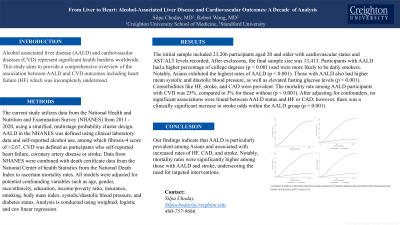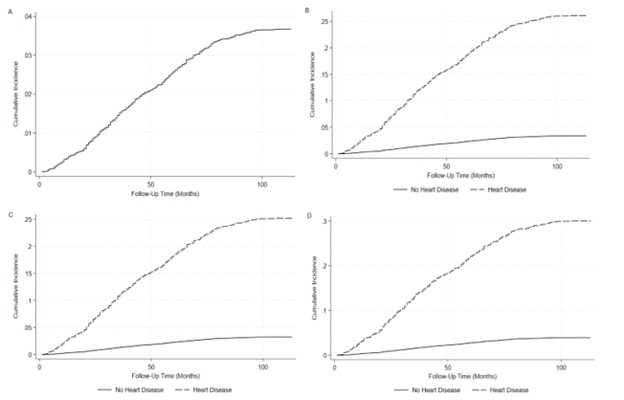Monday Poster Session
Category: Liver
P2962 - From Liver to Heart: Alcohol-Associated Liver Disease and Cardiovascular Outcomes: A Decade Analysis From National Survey
Monday, October 28, 2024
10:30 AM - 4:00 PM ET
Location: Exhibit Hall E

Has Audio

Silpa Choday, MD
Creighton University School of Medicine
Phoenix, AZ
Presenting Author(s)
Silpa Choday, MD1, Robert Wong, MD, MS, FACG2
1Creighton University School of Medicine, Phoenix, AZ; 2Stanford/VA Palo Alto, Palo Alto, CA
Introduction: Alcohol associated liver disease (AALD) and cardiovascular diseases (CVD) represent significant health burdens worldwide. This study aims to provide a comprehensive overview of the association between AALD and CVD outcomes including heart failure (HF) which was incompletely understood.
Methods: The current study utilizes data from the National Health and Nutrition and Examination Survey (NHANES) from 2011 - 2020, using a stratified, multistage probability cluster design. AALD in the NHANES was defined using clinical laboratory data and self-reported alcohol use, among which fibrosis-4 score of >2.67. CVD was defined as participants who self-reported heart failure, coronary artery disease or stroke. Data from NHANES were combined with death certificate data from the National Center of health Statistics from the National Death Index to ascertain mortality rates. All models were adjusted for potential confounding variables such as age, gender, race/ethnicity, education, income/poverty ratio, insurance, smoking, body mass index, systolic/diastolic blood pressure, and diabetes status. Analysis is conducted using weighted, logistic and cox linear regression.
Results: The initial sample included 23,206 participants aged 20 and older, with recorded cardiovascular status and AST/ALT levels. After excluding participants with hepatitis B, hepatitis C, metabolic dysfunction-associated fatty liver disease, and pregnant patients, the final unweighted sample size was 13,413. Participants reporting AALD had a higher percentage of college degrees (p< 0.001) and were more likely to be daily smokers. Asians exhibited the highest rates of AALD compared to other demographics (p< 0.001). Those with AALD also had higher mean systolic and diastolic blood pressure, as well as elevated fasting glucose levels (p< 0.001). Comorbidities such as HF, stroke, and coronary artery disease (CAD) were prevalent. The mortality rate among AALD participants with CVD was 25%, compared to 3% among those without CVD (p< 0.001). After adjusting for potential confounding variables, no statistically significant associations were found between AALD status and HF or CAD. However, a clinically significant increase in the odds of stroke was observed within the AALD group (p< 0.001).
Discussion: Our findings indicate Asians have the highest rates of AALD. There is an increased prevalence of AALD with HF, CAD and stroke, and a significant increase in mortality with stroke.

Note: The table for this abstract can be viewed in the ePoster Gallery section of the ACG 2024 ePoster Site or in The American Journal of Gastroenterology's abstract supplement issue, both of which will be available starting October 27, 2024.
Disclosures:
Silpa Choday, MD1, Robert Wong, MD, MS, FACG2. P2962 - From Liver to Heart: Alcohol-Associated Liver Disease and Cardiovascular Outcomes: A Decade Analysis From National Survey, ACG 2024 Annual Scientific Meeting Abstracts. Philadelphia, PA: American College of Gastroenterology.
1Creighton University School of Medicine, Phoenix, AZ; 2Stanford/VA Palo Alto, Palo Alto, CA
Introduction: Alcohol associated liver disease (AALD) and cardiovascular diseases (CVD) represent significant health burdens worldwide. This study aims to provide a comprehensive overview of the association between AALD and CVD outcomes including heart failure (HF) which was incompletely understood.
Methods: The current study utilizes data from the National Health and Nutrition and Examination Survey (NHANES) from 2011 - 2020, using a stratified, multistage probability cluster design. AALD in the NHANES was defined using clinical laboratory data and self-reported alcohol use, among which fibrosis-4 score of >2.67. CVD was defined as participants who self-reported heart failure, coronary artery disease or stroke. Data from NHANES were combined with death certificate data from the National Center of health Statistics from the National Death Index to ascertain mortality rates. All models were adjusted for potential confounding variables such as age, gender, race/ethnicity, education, income/poverty ratio, insurance, smoking, body mass index, systolic/diastolic blood pressure, and diabetes status. Analysis is conducted using weighted, logistic and cox linear regression.
Results: The initial sample included 23,206 participants aged 20 and older, with recorded cardiovascular status and AST/ALT levels. After excluding participants with hepatitis B, hepatitis C, metabolic dysfunction-associated fatty liver disease, and pregnant patients, the final unweighted sample size was 13,413. Participants reporting AALD had a higher percentage of college degrees (p< 0.001) and were more likely to be daily smokers. Asians exhibited the highest rates of AALD compared to other demographics (p< 0.001). Those with AALD also had higher mean systolic and diastolic blood pressure, as well as elevated fasting glucose levels (p< 0.001). Comorbidities such as HF, stroke, and coronary artery disease (CAD) were prevalent. The mortality rate among AALD participants with CVD was 25%, compared to 3% among those without CVD (p< 0.001). After adjusting for potential confounding variables, no statistically significant associations were found between AALD status and HF or CAD. However, a clinically significant increase in the odds of stroke was observed within the AALD group (p< 0.001).
Discussion: Our findings indicate Asians have the highest rates of AALD. There is an increased prevalence of AALD with HF, CAD and stroke, and a significant increase in mortality with stroke.

Figure: Cumulative Incidence in Mortality within the overall population (A), between patients with and without heart disease (B), with further stratification by AFLD status (C-D)
Note: The table for this abstract can be viewed in the ePoster Gallery section of the ACG 2024 ePoster Site or in The American Journal of Gastroenterology's abstract supplement issue, both of which will be available starting October 27, 2024.
Disclosures:
Silpa Choday indicated no relevant financial relationships.
Robert Wong: Durect Corporation – Grant/Research Support. Exact Sciences – Grant/Research Support. Gilead Sciences – Grant/Research Support. Thera Technologies – Grant/Research Support.
Silpa Choday, MD1, Robert Wong, MD, MS, FACG2. P2962 - From Liver to Heart: Alcohol-Associated Liver Disease and Cardiovascular Outcomes: A Decade Analysis From National Survey, ACG 2024 Annual Scientific Meeting Abstracts. Philadelphia, PA: American College of Gastroenterology.
